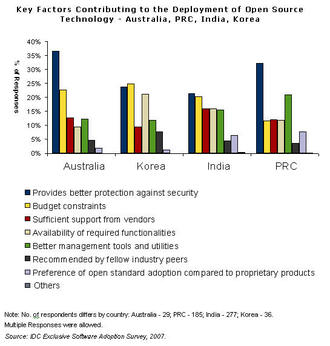IDC: Companies select open source for safety reasons
In a survey by market-researcher IDC, companies in Australia, Korea, India and China quote better protection against vulnerabilities gaps as the main reason for the implementation of Open Source technology.
The survey titled "The Momentum of Open Source" comes to the conclusion that organizations in India and the People’s Republic of China use more Open Source Software (OSS) than in Australia and Korea. In all four countries small to mid-sized enterprises (SMEs) deploy more free software than larger enterprises. "The results indicate that organizations perceived open source technology as providing better security compared to proprietary products", said Prianka Srinivasan, a market analyst with IDCs Asia/Pacific software research team. Although the market-researcher still see cost-efficiency as the key factor, OSS is now used for a precisely defined range of tasks.

Security is of the reasons for the implementation of Open Source software, says US market researcher IDC.
Decision makers all over the world use OSS primarily for security reasons, with economy taking second place. Korea is the only country where budget concerns are more important. SMEs in Korea also see the quality of the free software and better management tools as the main benefit. "IDC believes that open source technology and software will appear in the higher end of the application stack in the coming years", Srinivasan predicts, adding that "Commercial vendors of open source software will need to provide extensive support and training services, as well as address the issues of interoperability, in order to take advantage of the addressable market for open source technology in the region." The survey is based on the results and analyses of the more comprehensive IDC Exclusive Software Adoption Survey from 2007.
Subscribe to our Linux Newsletters
Find Linux and Open Source Jobs
Subscribe to our ADMIN Newsletters
Support Our Work
Linux Magazine content is made possible with support from readers like you. Please consider contributing when you’ve found an article to be beneficial.

News
-
Two New Distros Adopt Enlightenment
MX Moksha and AV Linux 25 join ranks with Bodhi Linux and embrace the Enlightenment desktop.
-
Solus Linux 4.8 Features Removes Python 2
Solus Linux 4.8 has been released with the latest Linux kernel, updated desktops, and a key removal.
-
Zorin OS 18 Hits over a Million Downloads
If you doubt Linux isn't gaining popularity, you only have to look at Zorin OS's download numbers.
-
TUXEDO Computers Scraps Snapdragon X1E-Based Laptop
Due to issues with a Snapdragon CPU, TUXEDO Computers has cancelled its plans to release a laptop based on this elite hardware.
-
Debian Unleashes Debian Libre Live
Debian Libre Live keeps your machine free of proprietary software.
-
Valve Announces Pending Release of Steam Machine
Shout it to the heavens: Steam Machine, powered by Linux, is set to arrive in 2026.
-
Happy Birthday, ADMIN Magazine!
ADMIN is celebrating its 15th anniversary with issue #90.
-
Another Linux Malware Discovered
Russian hackers use Hyper-V to hide malware within Linux virtual machines.
-
TUXEDO Computers Announces a New InfinityBook
TUXEDO Computers is at it again with a new InfinityBook that will meet your professional and gaming needs.
-
SUSE Dives into the Agentic AI Pool
SUSE becomes the first open source company to adopt agentic AI with SUSE Enterprise Linux 16.
